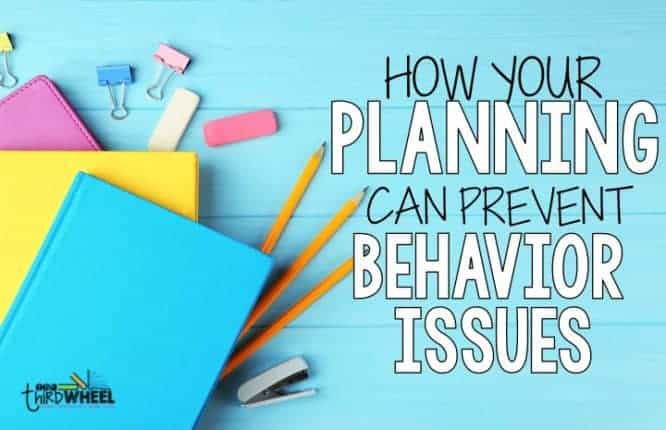6 Important Classroom Rules and Procedures Elementary Students Must Learn the First Week
The first week of school is not just stressful for the students; it is stressful for teachers, as well. As a new group of children descends upon the classroom, it can be hard to know where to begin, but we all know the importance of having an effective classroom. Do you spend your students’ first day teaching procedures and digging into the rules? Today I want to introduce the 6 classroom rules and procedures elementary teachers should introduce the first week of school.

Classroom Rules and Procedures Elementary Teachers Must Introduce the First Week
Do you spend the first day back to school having fun and leave rules for the future?
The key to a good school year is the tone set during the first week. This is when classroom rules, procedures, and schedules are shared. Spread the procedure lessons over the first week so the students don’t feel overwhelmed on the first day. Here are six must-teach classroom procedures for the first week of school.
1. Bathroom & Water Fountain Procedures
It’s inevitable. Kids have to use the bathroom and get drinks of water frequently throughout the day. This can be disastrous if there is no proper procedure associated with the process.
Explain the bathroom and water fountain rules during the first week of school. Explain to students the procedure for asking the teacher to go, appropriate and inappropriate times, and the expected behavior at both locations.
These procedures should be taught as early as possible to start the trend of expected behavior.
2. Behavior Management System
One of the most important things to teach children the first week of school is the classroom behavior management system and expectations.
Each teacher has a unique behavior management system and expectations for acceptable classroom behavior. Whatever your strategy for managing student behavior, starting it as soon as possible is important to maintain an orderly classroom.
Some teachers like to use green, yellow, and red cards where kids have to change their cards for certain misbehaviors. Other classroom management systems include clipping up and down depending on positive or negative behavior or earning points on an individual point sheet.
In addition to these individual classroom management techniques, explaining any group reward systems you have, such as table points or a “teachers vs. students” game, is important.
While introducing the reward side of the system is important and a fun way to engage students, you must clearly explain the expectations and consequences for your classroom.
3. Line Procedures
Lining up is a procedure that happens multiple times a day. Students spend a lot of time lining up between specials, lunch, recess, and dismissal.
Teach this procedure on the first day of school so students know what to do. Then practice, practice, practice that first week to help students develop good habits.
Before the year begins, consider whether you plan to establish a line order. This is a good solution if you’ve had trouble with line behavior or want to avoid any potential issues with students fighting over where they stand.
Lining up the kids in set spots, typically in alphabetic order, is a good way to keep order in the line. This will prevent kids from fighting over spots in line and pushing to be the line leader or next to their friends.
Spend a few extra minutes on line-up procedures during the first few days of school. While it takes time, practicing these procedures early and often makes transitions easier for the rest of the school year.
4. Morning Work Procedures
Morning work sets the tone for each school day, especially if students arrive at various times. As students come in and unpack, you need some tasks to focus on for a day of learning. You might decide to use this time for silent reading or as a chance to do some spiral review for language arts or math.
Regardless of your decision, you must use this time to set the tone for the day. If you start the day with activities that create chaos, you can expect that chaos will trickle over into the rest of the day’s learning.
During the first week of school, you set the tone. Teach students specifically what is expected upon arrival and reinforce your expectations daily.
While your first-day activities will likely look different, you can take time later that afternoon to teach the expected morning routine and get started as early as Day 2. This can help build a routine that can carry your students through the whole school year.
5. Supply Management Procedures
Crayons, paper, notebooks, rulers, oh my!! Supplies are a huge part of the school day. That’s why it is so important to have a well-planned system for how students will manage these tools.
- What will they keep at their desks, and how will they keep it organized?
- Will you have table supplies, or will each student keep their supplies?
- Where will you keep supplies that are used infrequently?
There are many things to consider when planning how to manage supplies in your classroom. Realistically, most students will have a set of personal supplies kept on their desks and then access to a class set of supplies shared by all.
Establish supply rules and procedures to ensure the smooth use and access of supplies. For example, you’ll want to decide how many pencils students will keep at their desks vs. how many you’ll store and hand out as needed. If you’re wondering, 3-5 pencils typically work well for older students. You can bump that down to 2 pencils for younger kiddos, as they tend to get lost more easily.
Think about classroom procedures for how you’ll manage sharpening pencils. Can students walk up and sharpen their pencils, or can it only be used during certain times?
Alternatively, you might consider having pencil sharpening be a classroom job. In that case, as their pencils become dull, they have a “dull” pencil box in which they can place their old pencils and a “sharp” pencil box where they can grab a new sharp pencil.
At the end of each day, your pencil sharpener can take care of the dull pencils and prepare them for the next day. This prevents students from loudly sharpening their pencils during lessons and gives them quick access to sharp pencils when needed. Create similar procedures for the various other supplies used during the school day.
6. Arrival & Dismissal Classroom Procedures
Teaching students how to enter and leave your classroom for the day is essential to making your year successful, and you need to start students on the right track from day one.
After your class arrives on the first day, spend some time teaching them how they’ll come into the classroom, where they’ll put their things, and what they should do once they’ve gotten everything put away.
Similarly, teach students how to wrap up the day. Be sure students understand your expectations for packing up and how the room should look when you leave for the day. Teach them where they’ll go at dismissal. Doing this early in the afternoon on the first day can alleviate many end-of-day stress for you and your students.
Getting Started with Rules and Classroom Procedures Elementary Teachers Must-Teach the First Week
The six procedures listed above are examples of important classroom routines and procedures to teach during the first week of school. There are likely many other classroom procedures you’ll want to teach as well.
Create a checklist to help you stay organized and ensure you’ve taught all the important procedures to help students succeed in your classroom or click the button to grab my FREE Routines & Procedures Checklist and save yourself some time.
Most importantly, don’t make the first day of school boring by spending hours droning on about the rules and classroom procedures. Prioritize procedures and spread the lessons throughout the first week of school. This allows students to internalize these expectations and prevent behavior issues later.






